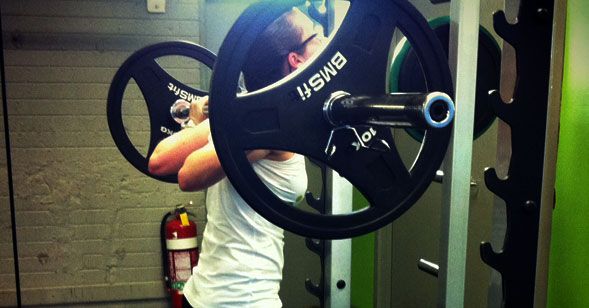Powerlifting - Deconstructing the Squat
As a competitive powerlifter, I do a LOT of squats in my training, with many variations, such as back squats, box squats, and front squats. In this post today I will break down the the correct way to perform a back squat, as per the way I perform them in powerlifting competitions.
Set-up
A correct squat begins at the squat rack, and a good set-up is paramount to performing quality squats, especially when the weight starts to get heavy. A good set-up will mean that you easily and quickly get into the correct position to perform your squats, without wasting much needed energy.
Set the rack height so that the bar is roughly in line with the middle of your sternum. Now, many of you may think this bar position is too low, however it is better to have the weight low than having to get on your tip toes to take the weight off the rack.
Stand in front of the squat rack and take an even grip on the bar. Grip width will vary depending on your flexibility, but chose what is most comfortable. When I perform squats, I hook my thumb under the bar, but many lifters have their thumbs placed on top of the bar.
With your grip ready, duck under the bar and come up into a position where the bar is centred against your upper back, not on top of your shoulders. The bar should be positioned roughly in line with the top of your rear deltoids. This position gives you a better leverage when performing a squat, than if you had the weight higher on your back.
Now, keep your head up, squeeze your shoulder blades together and place your feet approximately hip width apart. Now stand up to take the bar off the rack.
You're now standing up, but you will need to step back from the rack in order to perform your squat. To ensure you always have the same squat position, you should always step back from the rack the same way every time you squat. This will help you not to waste energy in moving your feet position once you have the weight loaded on your back.
Step one foot back, then the other, then step one foot out to the side, then the other, so that your feet are just past shoulder width apart and your toes pointing out approximately 30 degrees. Some people's squat stance may vary, however a very wide stance makes it harder to get depth in your squat, and a narrow stance prevents your adductors (inner thighs) from stretching, which again can prevent proper depth.
Squat - The Descent
The timing of your downward movement is critical to a good squat. But before you descend, take a deep breath (and hold it until you come back up to standing at the end of the lift). With your eyes up and knees flared out to the side squat down by moving your hips back and down. Do not just bend from the knees - a good squat is executed with hip movement. Note, I lift looking up and find this to be the strategy that works for me in my max lifts, however there are many lifters out there that look downwards.
As you descend, you need to accelerate when approaching the bottom of the lift, I call this the "bounce". This acceleration, when timed correctly, will not only allow you to get to depth easier (and by depth, I mean the top of your knee is higher than your hip) but also propel you on the way up. The bottom part of the squat is called the "hole" and this is the hardest part of the lift. If you are able to accelerate and "bounce" out of the "hole" you limit the amount of work you have to do coming back out of it.
A key point though, is not to drop into the hole, as dropping means that you are relaxing some of your muscles, which means when the weight is heavy it will be unlikely that you will be able to lift the weight back up. Be sure to keep everything tight.
Squat - The Ascent
If you have timed the bounce correctly, you should be making your way out of the squat before you know it! The key is to use the bounce to propel yourself out of the bottom of the lift. Once you start ascending be sure to keep your back tight, knees flared out, and focus on bring your hips forward and up. At the top of the lift release your breath.
The Finish
By now you have finished your squat. Congratulations! Step back towards the bar and re-rack the weight. If you are attempting heavy squats be sure to have experienced people spotting your lifts and helping you re-rack the weight. Spotters are an essential part of powerlifting, and are there for your safety.
Watch and Learn
For a visual demonstration of what I have outlined above, watch the video below:
To learn about the benefits of squats, read my blog post, Why Everyone Should Put Squats Into Their Workout.
Coming Up...
Im my next post, I will deconstruct the bench press. Until then, get squatting!

